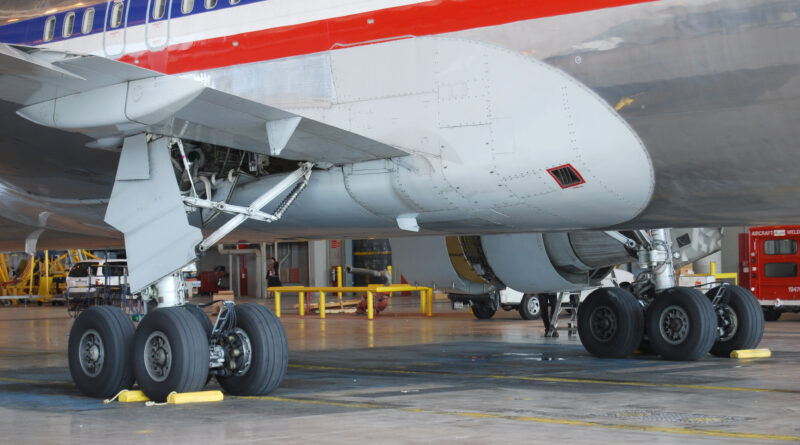Stowaway Found Dead Inside American Airlines Landing Gear Compartment in Charlotte North Carolina
On September 28, 2025, maintenance personnel at Charlotte Douglas International Airport in Charlotte, North Carolina, discovered a deceased individual inside the main landing gear compartment of an American Airlines aircraft during a post-arrival inspection. The discovery immediately triggered a multi-agency response that included airport police, city homicide investigators, federal aviation and border authorities, and airline safety and maintenance leadership. While the person’s identity, nationality, and journey remained unknown in the first hours after the incident, the circumstances strongly indicated a wheel-well stowaway scenario—a rare but highly lethal form of clandestine travel. What follows is a comprehensive, source-free narrative explaining what is known, how such incidents are investigated, the technical environment of a landing gear bay, the medical realities of wheel-well exposure at cruise altitude, and the operational, legal, and humanitarian implications for airports, airlines, and the community.
The Immediate Incident
Shortly after the flight parked at a gate or remote stand and the aircraft was set to a safe configuration, routine post-flight maintenance checks began. These inspections typically include exterior walk-arounds, tire and brake examinations, leak checks, and visual assessments of structural surfaces and access panels. When technicians opened or inspected the main landing gear area—an enclosed volume that houses the struts, retraction actuators, hydraulic lines, electrical wiring, brake lines, and the wheel assemblies—they found an unresponsive person within the bay. The discovery paused maintenance activity, and the area was secured.
Airport operations called for first responders, including the airport division of local law enforcement. Officers established a perimeter, halted any equipment movements that could disturb the scene, and initiated a death investigation protocol. Emergency medical personnel confirmed there were no signs of life. The aircraft’s status shifted from routine turnaround to a controlled scene pending law-enforcement clearance, and downstream flight operations were adjusted to accommodate the investigation.
Securing the Scene at CLT
Charlotte Douglas International Airport is one of the nation’s busiest hubs, with complex ramp logistics and narrow scheduling margins. When an aircraft becomes the focus of a death investigation, the airport’s incident command model activates. Ramp traffic near the gate is restricted, and access is limited to essential personnel—officers, airline security, maintenance managers, and investigators. The primary objectives are to preserve evidence, ensure safety (particularly if hydraulic systems were recently pressurized or if gear doors are partially open), and maintain broader operational flow across the field.
Physical evidence within a landing gear bay can be delicate: hydraulic fluid residue, scuff marks on structural members or wheel hubs, fibers on gear-door seals, and objects dislodged during gear retraction or extension. Investigators photograph the compartment from multiple angles, document any foreign materials, and identify potential ingress points—most commonly near the main gear wells where the doors open during taxi, takeoff, and landing sequences. If the aircraft had flown a long-haul route, investigators also consider the potential that evidence originated at the departure field.
What a Landing Gear Bay Is—and Isn’t
To appreciate the risks, it helps to understand the space. A main landing gear bay is not a cargo hold. It is unpressurized, unheated, loud, and mechanically complex. During gear retraction after takeoff, the wheels and strut fold into the bay; doors close and the assembly is locked. The bay shares the ambient conditions of the atmosphere outside the fuselage during flight, meaning temperatures can plummet to far below freezing and oxygen partial pressure drops sharply at cruising altitudes. Moving components, including torque links and down-lock mechanisms, occupy much of the internal volume and can shift as the aircraft cycles from deployed to stowed configurations.
Clearance between the wheels and structural members is narrow. Gear doors, if they close on anything protruding into the opening, can exert crushing forces. Vibration, aerodynamic buffeting, and hydraulic line routing further complicate any attempt at concealment. Importantly, no commercial aircraft is designed to transport people in that space; there are no restraints, no breathable air supply, no heat, and no protection from moving machinery once the takeoff sequence begins.
Wheel-Well Stowaways: Physiology and Probability
Human physiology becomes a severe constraint at altitude. As a transport category jet climbs, the unpressurized wheel-well environment tracks the outside air: temperatures may drop to −40°C or lower, and oxygen availability decreases with altitude, driving hypoxia. Without supplemental oxygen, a person can lose consciousness quickly at cruising levels. Even if partial consciousness persists, the combination of cold and hypoxia is typically unsurvivable across hours-long flights. On descent, the environment warms and oxygen density increases, but by then fatal injuries—hypoxic brain injury, cardiac arrhythmia, or severe hypothermia—are likely. Survivals have been documented only in exceedingly rare circumstances (often at lower-altitude, shorter flights, or with physiological factors that happened to extend tolerance). The overwhelming majority of wheel-well entries end in death.
How Investigators Reconstruct the Journey
When an unidentified person is found in a wheel well, the central investigative questions are: who is the person, where did they enter the aircraft, how did they access the ramp and gear area, and whether any accomplices facilitated the attempt.
Identity Determination
Identification often begins with basic field observations—clothing, personal effects, distinctive marks—followed by a formal medico-legal process. The medical examiner leads post-mortem identification using fingerprints (if obtainable), dental records, tattoos, DNA, or other biometrics. If identification materials are absent, investigators may cross-reference airline manifests from recent flights that serviced the aircraft, but wheel-well stowaways are not listed on passenger records; the manifest method is used instead to narrow the aircraft’s recent movements.
Aircraft Tracking
Airline maintenance and operations records show where the aircraft has been over the past days: departure cities, intermediate stops, tail-number swaps, and overnight locations. Investigators compare this movement history with reports of perimeter breaches or missing persons in departure regions. If the aircraft arrived from another country, federal partners coordinate with foreign authorities to review security footage, perimeter sensors, and gate assignments at the origin and any intermediate fields.
Ramp and CCTV Review
Airports deploy an array of cameras covering gates, hangars, and movement areas. However, camera coverage in the exact vicinity of gear doors can vary. Investigators review inbound arrival footage, gear-door cycles, and any unusual activity near the nose or main gear both at departure and arrival. Time synchronization across systems—aircraft flight data, gate control logs, CCTV time stamps, and airline maintenance software—is critical to constructing an accurate sequence.
Forensic Examination of the Bay
Within the gear well, investigators look for transfer evidence: fibers on struts, imprints on gear doors, smudges on composite interiors, or abrasions on brake assemblies. They also check for luggage tags, paper fragments, or cellphone components. If some items are wet or frozen, they are handled under chain-of-custody procedures and thawed or dried in controlled conditions to preserve trace evidence.
Multi-Agency Roles and Jurisdiction
A death on an aircraft at a U.S. airport engages layered authority:
- Local Law Enforcement: The airport division and city homicide investigators secure the scene, manage immediate evidence collection, and initiate the death investigation under state law.
- Medical Examiner: Leads determination of cause and manner of death, manages identification, and retains evidentiary custody of the remains.
- Federal Aviation Partners: While wheel-well deaths are not aviation accidents in the classic sense, federal aviation regulators may assist on questions of aircraft access and security procedures.
- Customs and Border Enforcement: If the aircraft arrived from abroad, federal border authorities coordinate with airline security to determine potential immigration or trafficking concerns, even though a wheel-well entry is unauthorized and outside normal immigration channels.
- Airline Security and Maintenance: The airline’s corporate security liaises with law enforcement; maintenance teams support safe access to the bay, provide technical drawings if needed, and document any damage or anomalies on the aircraft.
This framework aims to answer security questions without delaying the medical and humanitarian tasks of identifying and notifying next of kin.
American Airlines’ Operational Response
When an event like this occurs, the airline’s immediate obligations are safety, cooperation, and care. The aircraft is pulled from service until law enforcement releases it and maintenance verifies that no mechanical harm was done to gear doors, seals, tires, brake lines, or hydraulic systems. If contamination occurred within the bay (biological fluids, debris), specialized cleaning follows regulated sanitation protocols. The flight schedule is adjusted—often with a substitute aircraft—and affected customers are reprotected or rebooked. Internally, the airline’s crisis team documents the timeline, notifies leadership, and prepares talking points for public communications that acknowledge the event, avoid speculation, and commit to supporting the investigation.
Airport Operations and Continuity
A major hub cannot afford cascading delays. Airport operations isolate the affected gate and reroute ramp traffic. If the aircraft was at a remote stand, buses and tugs are redirected to clear a wider safety perimeter. Terminal operations keep passengers informed in a neutral tone that avoids interfering with the investigation. The airfield’s incident command keeps a common log—time of discovery, arrival of units, evidence milestones, release of the aircraft—to enable after-action reviews that improve coordination for future events.
Security Considerations: How Could This Happen?
Airports employ layered security: perimeter fencing, patrols, vehicle checkpoints, badge controls, and video analytics. Yet the physical reality of global aviation is that aircraft spend time on the ground at many airports with varying levels of perimeter protection. Potential avenues for illicit ramp access include perimeter breaches in remote areas, exploitation of busy ramp periods, tailgating behind authorized vehicles, or collusion with badged personnel. Investigators examine origin and intermediate stops for any anomalies—fence cuts, reports of trespassers, or unusual activity caught on cameras. The objective is not to assign blame reflexively but to identify actionable control gaps: lighting coverage, blind spots in CCTV, patrol frequency, or badge compliance.
Medical and Forensic Realities of Wheel-Well Deaths
From a forensic perspective, wheel-well cases often display signs consistent with hypothermia and hypoxia, sometimes combined with blunt trauma from moving gear components or debris impact during takeoff and landing. The medical examiner documents core body temperature at discovery (noting that post-mortem changes complicate interpretation), examines extremities for freezing injury patterns, and catalogs clothing layers. Toxicology may be performed to rule out substances that could have impaired judgment, although many victims resort to wheel-well entry out of desperation rather than intoxication.
Identification can be protracted. If fingerprints are degraded by cold injury, advanced techniques and international data sharing may be needed. DNA matching requires candidate relatives or reference databases; if the individual originated from a region with limited records infrastructure, consular channels become essential. Throughout, investigators keep in view the human dimension: somewhere, a family may be searching for a missing person.
Historical Context and Risk Profile
Wheel-well stowaway attempts are statistically rare relative to the volume of global flights, but they reoccur often enough to constitute a known risk category. Most involve long-haul aircraft because the larger gear bays sometimes provide marginally more space to conceal oneself before doors close. The lethality is high: extreme cold, lack of oxygen, and mechanical hazards combine to make survival unlikely on flights of typical cruise altitudes and durations. The grim recurrence underscores a broader global context—conflict, economic desperation, or personal crises—that drive people to attempt impossibly dangerous paths.
Legal Framework and Liability Questions
Legally, unauthorized access to an airfield and aircraft is a criminal act, but in the aftermath of a death the focus is on investigation and system improvement rather than prosecution of the deceased. For airports and airlines, the question becomes one of due diligence: Were standard security measures in place? Were there documented breaches at the origin field? Were airline ramp procedures followed? Regulatory bodies can issue recommendations if gaps are discovered. Civil liability is uncommon in such cases because the person entered a restricted, inherently hazardous space without authorization, but findings can still drive investments in security enhancements and training.
Communications with the Public
Transparent, measured communication helps maintain public trust. Airports typically acknowledge the incident, confirm operational status, and defer investigative details to law enforcement. Airlines express condolences, affirm cooperation, and provide operational updates for customers. Law enforcement agencies release updates as identification progresses—first noting the discovery, then clarifying investigative scope, and eventually providing identity and next-of-kin notifications when appropriate. Responsible communication avoids speculation about the person’s origin or motive until facts are established.
Humanitarian Considerations and Dignity in Procedure
Even as the event raises security and operational issues, the central fact is the loss of a human life. Investigators and medical examiners are mindful of dignity, handling remains with care and confidentiality. If international coordination is required, consular officials are engaged to aid in identification and repatriation. Community groups may respond with vigils or appeals to empathy, recognizing that behind the headlines is often a story of hardship and hope that ended in tragedy.
Operational Lessons for Airlines and Airports
After-action reviews typically generate practical steps:
- Perimeter Audits: Validate fence integrity, lighting coverage, and sensor performance, particularly in low-traffic areas where aircraft may overnight.
- Camera Analytics: Expand coverage of gate areas and gear-door sightlines; improve time-sync across systems to strengthen evidentiary value.
- Badge and Vehicle Control: Reinforce anti-tailgating procedures, randomize inspections, and audit airside vehicle movements for anomalies.
- Maintenance Protocols: Formalize additional cues for technicians to watch during exterior inspections—unusual odors, fibers, or marks near gear doors—and standardize reporting channels.
- International Coordination: Share lessons with partner stations abroad where the aircraft operates, ensuring security baselines are understood and monitored.
Community Impact in Charlotte
For the Charlotte community, the event is unsettling precisely because it unfolded adjacent to familiar routines—arrivals, connections, work trips, family reunions. Airport staff, flight crews, and passengers may experience distress. Employee assistance programs, peer support teams, and chaplaincy services often mobilize after such incidents to help workers process what they encountered. Public reactions tend to mix sorrow for the deceased with questions about safety and global inequality that push people toward such desperate acts.
Open Questions Likely to Be Answered Later
In the days and weeks after the discovery, several questions typically move toward resolution:
- Identity and Next of Kin: Confirmation through fingerprints, dental records, or DNA; notification of family.
- Point of Ingress: Determination of the airport and approximate time the individual accessed the ramp and aircraft.
- Security Gaps: Whether any breach or procedural lapse contributed, and what corrective actions are taken.
- Flight Operational Impacts: Confirmation that the aircraft sustained no damage, or documentation and repair if it did.
- Policy Adjustments: Any updated training, patrol routes, or technological enhancements implemented at origin and destination airports.
Conclusion
The death of an unidentified person in the main landing gear compartment of an American Airlines aircraft at Charlotte serves as a stark reminder of the intersection between global human desperation and the unforgiving physics of high-altitude flight. The landing gear bay is a mechanical cavity never intended for human occupancy; it becomes a lethal trap once the aircraft rotates and climbs. For investigators, the priorities are to identify the deceased, reconstruct the path that led to the attempt, and close any security gaps without disrupting the essential flow of airport life. For the airline and airport, it is about cooperation, empathy, and continuous improvement. For the community, it is a moment to balance the need for safety with recognition of the human story behind an act that ended in tragedy. As facts are established, the narrative will sharpen; until then, the framework above summarizes how such cases are understood, investigated, and learned from in modern aviation.
Discover more from City Towner
Subscribe to get the latest posts sent to your email.




